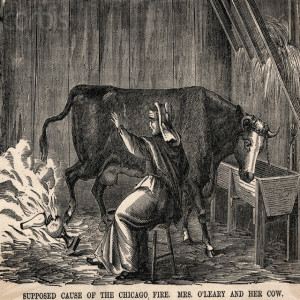
On this day in Labor History the year was 1871.
That was the day that the Great Chicago Fire began.
The fire started in a barn on the property of Patrick and Catherine O’Leary.
Legend pins the blame for starting a fire on a cow.
Whatever the cause, the fire spread quickly through the cities wooden houses.
For two days the uncontrollable fire raged destroying everything in its path.
In the wake of its devastation nearly 300 people died and 100,000 families had their homes destroyed.
One person who lost her business in the fire was renowned labor leader Mother Jones.
In her autobiography she wrote about the fire destroying her dress shop saying, “the great Chicago fire burned up our establishment and everything that we had. The fire made thousands homeless. We stayed all night and the next day without food on the lake front, often going into the lake to keep cool.”
Millions of dollars were raised by the Chicago Relief and Aid Society to help those who needed help to rebuild.
While the society did provide significant aid, treatment varied along class lines.
To get assistance, the working class had to prove themselves worthy with personal references.
Middle class applicants for aid were more likely to be quickly approved to get money to rebuild.
Working class people had to wade through long approval processes.
Some never received that approval.
The experience galvanized some members of the working class to organize for change.
One of them was Mother Jones.
She wrote, “From the time of the Chicago fire I became more and more engrossed in the labor struggle and I decided to take an active part in the efforts of the working people to better the conditions under which they worked and lived.”
More Episodes
 2024-07-13
2024-07-13
 2024-07-12
2024-07-12
 2024-07-10
2024-07-10
 2024-07-09
2024-07-09
 2024-07-08
2024-07-08
 2024-07-06
2024-07-06
 2024-07-05
2024-07-05
 2024-07-03
2024-07-03
 2024-07-02
2024-07-02
 2024-07-01
2024-07-01
 2024-06-23
2024-06-23
 2024-06-23
2024-06-23
 2024-06-23
2024-06-23
 2024-06-23
2024-06-23
Create your
podcast in
minutes
- Full-featured podcast site
- Unlimited storage and bandwidth
- Comprehensive podcast stats
- Distribute to Apple Podcasts, Spotify, and more
- Make money with your podcast
It is Free
- Privacy Policy
- Cookie Policy
- Terms of Use
- Consent Preferences
- Copyright © 2015-2024 Podbean.com




